| June 04, 2008 |  |
MarsDaily Advertising Kit |
| Previous Issues | May 30 | May 29 | May 28 |
Phoenix Scoops Up Some Martian Soil Pasadena CA (JPL) Jun 02, 2008
Pasadena CA (JPL) Jun 02, 2008One week after landing on far-northern Mars, NASA Phoenix spacecraft lifted its first scoop of Martian soil as a test of the lander's Robotic Arm. The practice scoop was emptied onto a designated dump area on the ground after the Robotic Arm Camera photographed the soil inside the scoop. The Phoenix team plans to have the arm deliver its next scoopful, later this week, to an instrument tha ... more Five Years Of Mars Express  Bonn, Germany (SPX) Jun 03, 2008
Bonn, Germany (SPX) Jun 03, 2008Now more than ever, Mars is the focus of planetary research. A week after the resoundingly successful landing manoeuvre of NASA's Phoenix probe, scientists and engineers are celebrating the five-year anniversary of the launch of Mars Express, the first ever European planetary mission. The mission has already been extended a second time. "Mars Express has shown that Europe can assume a very ... more Phoenix Lander Robotic Camera Sees Possible Ice  Tucson AZ (SPX) Jun 03, 2008
Tucson AZ (SPX) Jun 03, 2008Scientists have discovered what may be ice that was exposed when soil was blown away as NASA's Phoenix spacecraft landed on Mars last Sunday, May 25. The possible ice appears in an image the robotic arm camera took underneath the lander, near a footpad. "We could very well be seeing rock, or we could be seeing exposed ice in the retrorocket blast zone," said Ray Arvidson of Washington Univ ... more Mars probe Phoenix flexes robotic arm  Washington (AFP) May 29, 2008
Washington (AFP) May 29, 2008NASA's Phoenix Mars lander flexed its robotic arm Thursday in a successful test of the key element in the probe's mission to investigate the Red Planet's soil for conditions conducive to life, NASA said. "The arm is ready to go," said Matt Robinson of the US space agency's Jet Propulsion Laboratory in Pasadena, California, where the Phoenix mission is managed. "Yesterday we sent commands ... more ATK Ultraflex Solar Arrays Deploy And Provide Critical Power To The Mars Phoenix Lander  Minneapolis MN (SPX) May 29, 2008
Minneapolis MN (SPX) May 29, 2008Alliant Techsystems reports that the Ultraflex Solar Arrays deployed and now provide power to the Mars Phoenix Lander. This is the first flight for this unique solar array technology developed by ATK's Goleta, California facility. Each Ultraflex array unfolded like an oriental fan into a circular shape 2.1 meters in diameter and will generate 770 watts of power from sunlight at the distanc ... more |
mars-phoenix
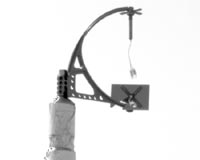 mars-phoenix 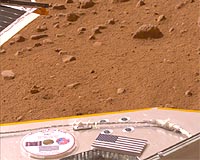 mars-phoenix 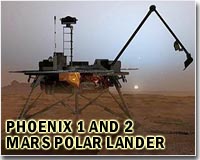 |
 Paris, France (ESA) May 29, 2008
Paris, France (ESA) May 29, 2008With data recorded on board Mars Express, you can hear Phoenix descend on to the surface of the Red Planet. After being processed by the Mars Express Flight Control Team, the sounds of Phoenix descending are audible, loud and clear. The data from the Mars Express Lander Communication system (MELACOM) that tracked Phoenix was received on Earth soon after the Phoenix landing. ... more Russia Watches Another American Robot Visit The Red Mars Again  Moscow (RIA Novosti) May 28, 2008
Moscow (RIA Novosti) May 28, 2008It looks as if the Americans have turned their attention to the Red Planet for real. NASA's Phoenix Mars Lander touched down near the North Pole on May 25. The first shots sent back to the Jet Propulsion Laboratory (JPL) in California report that the probe is in excellent health. NASA is exhilarated. The very fact of a safe landing on Martian soil is already a success considering that it is the ... more Radio glitch hinders Mars lander mission  Washington (AFP) May 27, 2008
Washington (AFP) May 27, 2008A communications glitch between the Phoenix Mars probe and Earth has delayed operations, two days after the spacecraft landed on the Red Planet in search of conditions to support life, NASA said Tuesday. A "transient event" knocked out UHF radio transmissions between Phoenix and the Mars Reconnaissance Orbiter (MRO), which relays data and instructions between the Phoenix and Earth, said Fuk ... more NASA Mars Lander Prepares To Move Arm  Pasadena CA (JPL) May 28, 2008
Pasadena CA (JPL) May 28, 2008NASA's Phoenix Lander is ready to begin moving its robotic arm, first unlatching its wrist and then flexing its elbow. Mission scientists are eager to move Phoenix's robotic arm, for that arm will deliver samples of icy terrain to their instruments made to study this unexplored Martian environment. The team sent commands for moving the arm on Tuesday morning, May 27, to NASA's Mars R ... more |
mars-phoenix
 mars-mro 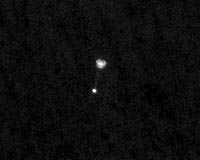 mars-phoenix 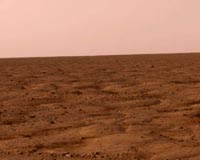 |
 Denver CO (SPX) May 27, 2008
Denver CO (SPX) May 27, 2008NASA has a new spacecraft operating on the surface of Mars. Late Sunday afternoon, the Phoenix Mars Lander, built by Lockheed Martin, navigated a dramatic blazing descent through the planet's atmosphere, positioning Phoenix to dig down and touch the planet's subsurface ice. At 4:24 p.m. Pacific Daylight Time May 25, onboard software commands fired six separation nuts and jettisoned the cru ... more Mars Cold Goes Down Deep  Moffett Field CA (SPX) May 27, 2008
Moffett Field CA (SPX) May 27, 2008New observations from NASA's Mars Reconnaissance Orbiter indicate that the crust and upper mantle of Mars are stiffer and colder than previously thought. The findings suggest any liquid water that might exist below the planet's surface and any possible organisms living in that water, would be located deeper than scientists had suspected. "We found that the rocky surface of Mars is no ... more The Radar SHARAD Completes The Mars Stratigraphy  Rome, Italy (SPX) May 26, 2008
Rome, Italy (SPX) May 26, 2008The radar sounder SHARAD of the NASA mission Mars Reconnaissance Orbiter has provided images of the Mars North Pole stratigraphy. This is the beginning of the article "Mars North Polar Deposits: Stratigraphy, Age and Geodynamical Response", published Friday on Science and prepared by a team of Italian and USA scientists, among which the radar scientific responsible, Dr. Roberto Seu, a scie ... more Phoenix Lands On Mars For First Polar Mission  Washington (AFP) May 25, 2008
Washington (AFP) May 25, 2008An ambitious effort to determine whether Mars' arctic region was ever habitable for microbial forms of life got underway Sunday when NASA landed the Phoenix probe near the Red Planet's north pole. After a nine-month journey from Earth, Phoenix managed an almost perfect landing in a relatively rock-free, flat target area, said Barry Goldstein, Phoenix project manager at the mission's control ... more
|
mars-phoenix
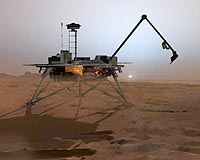 mars-phoenix 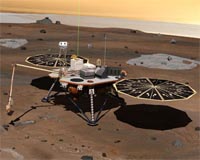 mars-phoenix  |
| Previous Issues | May 30 | May 29 | May 28 |
| The contents herein, unless otherwise known to be public domain, are Copyright 1995-2007 - SpaceDaily. AFP and UPI Wire Stories are copyright Agence France-Presse and United Press International. ESA Portal Reports are copyright European Space Agency. All NASA sourced material is public domain. Additional copyrights may apply in whole or part to other bona fide parties. Advertising does not imply endorsement, agreement or approval of any opinions, statements or information provided by SpaceDaily on any web page published or hosted by SpaceDaily. Privacy statement |